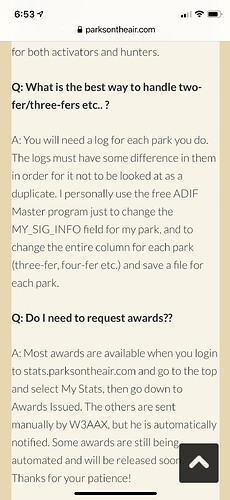Hi again…
Have been doing some more testing. This time I was messing around with entering 2fer, 3fer etc park activation info to see the results.
I do understand if more than one park is put in the MY_SIG_INFO or SIG_INFO the data requires more manipulation on my part to parse this data.
Here are my observations:
- See the attached Ref #1 & #2 & 3 when I tried to enter the data here it would not recognize the space bar entry note the results.
- I could input the P2P data in Comments Ref #4 but that still requires data manipulation
- The adi file: Info is there but with out spaces and data must be parse for multiple adi files
All to say this is just not a clean way of doing this however I appreciate there is only so much real estate on the display and this be the only recourse…entry to comments field may be best for P2P… allowing space entries in box #1 & 2 would help with data parsing and prepare multiple adi files.
However programmers can come up with some pretty cool solutions so I put it on the table for your consideration.
de Curt
ve3zn
